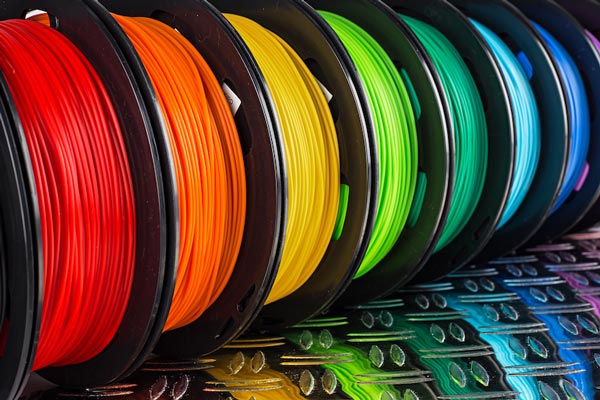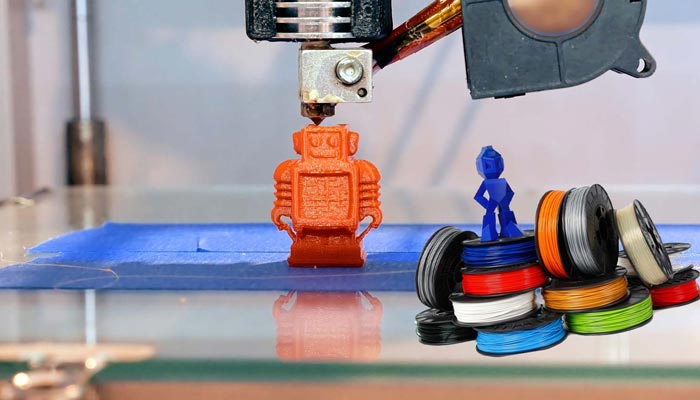A Beginner’s Guide- What Material Should I Use for 3D Printing?
3D printing is a process of making three dimensional solid objects from a digital file. The creation of a 3D printed object is achieved using additive processes. In an additive process an object is created by laying down successive layers of material until the entire object is created.
Each of these layers can be seen as a thinly sliced horizontal cross-section of the eventual object. 3D printing is an exciting and versatile technology that can be used to create objects in a wide range of materials. The most common material used for 3D printing is plastic, but there are many other types of materials that can be used, including metals, ceramics, and even food.
When choosing a material for 3D printing, it’s important to consider the properties of the material and how it will be used.
If you’re considering 3D printing, one of the first decisions you’ll need to make is what material to use. There are a variety of filaments available on the market, each with its own set of benefits and drawbacks. In this post, we’ll help you choose the right material for your next 3D printing project.
One popular choice for filament is PLA, or polylactic acid. PLA is derived from renewable resources like corn starch or sugar cane, making it a more environmentally friendly option than other materials. It’s also easy to print with and doesn’t require a heated bed, making it a good choice for beginners.
However, PLA can be brittle and isn’t as strong as some other options. Another common filament is ABS, or acrylonitrile butadiene styrene. ABS is tougher and more durable than PLA, making it ideal for items that will see heavy use.
It’s also easier to sand and paint after printing. However, ABS emits harmful fumes when printed at high temperatures, so it’s important to work in a well-ventilated area. There are many other filaments available on the market, including PETG (polyethylene terephthalate glycol), nylon ,and polycarbonate .
Each has its own unique set of properties that make it better suited for certain applications.
3D Printing Material Options
What Material Do I Need for 3D Printing?
3D printing is an additive manufacturing process that creates a three-dimensional object from a computer-aided design (CAD) model or other digital data source. The term “3D printing” can refer to a variety of different technologies and processes, but they all share one common trait: they build objects by adding layer upon layer of material until the desired shape is achieved. The most important thing you’ll need for 3D printing is a 3D printer.
But there are many different types of 3D printers, and each one uses different materials. So before you start shopping for a 3D printer, you need to decide what type of object you want to print, and what material it needs to be made from.
3D Printer
A 3D printer is a machine that creates three-dimensional objects by printing layers of material one on top of the other. Unlike traditional printers, which print two-dimensional images on paper, a 3D printer can create any shape that you can imagine. The first 3D printers were invented in the 1980s, but they were too expensive for most people to afford.
In the last few years, however, 3D printers have become much more affordable, and now anyone can own one. 3D printers work by extruding molten plastic or other materials through a nozzle onto a build platform. The object is built up layer by layer until it is complete.

This process is called additive manufacturing, because it adds material to create an object rather than subtracting it (like traditional manufacturing methods do). 3D printing has many applications in both the consumer and industrial worlds. Consumers can use 3D printers to create everything from toys to jewelry to replacement parts for their homes.
Businesses can use them to create prototypes of new products, or even to manufacture finished goods on-demand. There are already many different types of 3D printers available on the market, and new models are being released all the time. So if you’re interested in this fascinating technology, there’s never been a better time to get involved!
There are two broad categories of materials that can be used for 3D printing: thermoplastics and photopolymers.
Thermoplastics
Thermoplastics are traditional plastics that can be melted and reformed over and over again. Photopolymers are light-sensitive resins that harden when exposed to ultraviolet (UV) light. Each type of material has its own advantages and disadvantages, so it’s important to choose the right one for your project.
Thermoplastics are the most commonly used materials for 3D printing, because they can be easily melted and reformed into any shape imaginable. The three most popular thermoplastics used in 3D printing are acrylonitrile butadiene styrene (ABS), polylactic acid (PLA), and high-impact polystyrene (HIPS). ABS is strong and durable, making it ideal for objects that will see heavy use; PLA is biodegradable, so it’s a good choice for eco-friendly projects; HIPS is easy to work with and doesn’t require support structures during the printing process, making it ideal for complex designs.
Photopolymers
Photopolymers are typically used for more specialized applications, such as creating prototypes or models with very fine details. The two most common photopolymers used in 3d printing are stereolithography resin (SLA) and digital light processing resin (DLP).

What is the Easiest Material to 3D Print?
There is no definitive answer to this question as it depends on a number of factors, including the type of 3D printer you are using and your own personal preferences. However, in general, PLA and ABS are considered to be the easiest materials to 3D print with. Both of these materials are widely available and relatively inexpensive, and they can be printed using a wide range of printers.
PLA is generally considered to be the easier of the two to work with, as it has a lower melting point and is less likely to warp or shrink during printing. ABS is slightly more difficult to work with, but it is stronger and more durable than PLA.
How Do I Choose a 3D Printer Material?
3D printer materials come in a variety of types and each has its own unique set of properties. The most common 3D printer materials are plastics, metals, and ceramics. Each of these materials has different benefits and drawbacks that you should take into account when choosing a 3D printer material.
Plastics are the most common type of 3D printer material. They are relatively inexpensive and easy to work with. However, plastics can be difficult to print with high detail and they are not as strong as other materials.
Metals are another popular type of 3D printer material. They offer superior strength and durability compared to plastics. However, metals can be expensive to print with and require more specialized equipment.
Ceramics are a less common type of 3D printer material but they offer some unique benefits. Ceramics are very strong and resistant to heat, making them ideal for applications where those properties are important. However, ceramics can be difficult to print with high detail due to their brittle nature.
What Material is Not Suitable for 3D Printing?
3D printing technology has come a long way in recent years, but there are still some materials that are not suitable for 3D printing. Here are some of the most common materials that cannot be 3D printed: – Metals: Metals are difficult to 3D print because they require high temperatures to melt and flow properly.
Additionally, metals tend to be very strong and hard, which can make them difficult to work with during the printing process. – Glass: Glass is another material that is difficult to 3D print. This is because glass does not have a melting point, so it cannot be melted and formed into the desired shape.
Additionally, glass is fragile and can break easily, making it unsuitable for many 3D printing applications. – Ceramics: Ceramics are also difficult to 3D print. This is because they need to be heated at extremely high temperatures in order to form properly.
Additionally, ceramics can be brittle and break easily, which makes them unsuitable for many uses.
Conclusion
There are a variety of materials that can be used for 3D printing, each with its own advantages and disadvantages. The most common material is plastic, which is relatively inexpensive and easy to work with. However, plastic is not as strong or durable as other materials, so it may not be the best choice for all applications.
Metal, on the other hand, is much stronger but more expensive and difficult to work with. Other materials like wood or glass can also be used, but they have specific limitations that make them less suitable for some applications. Ultimately, the best material to use for 3D printing will depend on the specific needs of the project.

